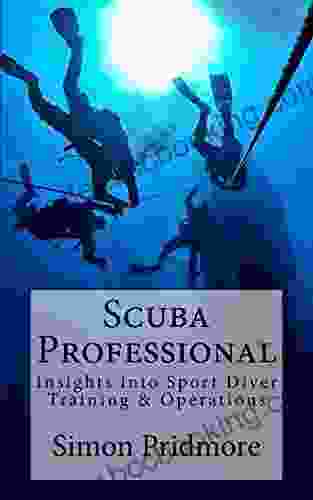Insights Into Sport Diver Training Operations: The Scuba

Scuba diving is a popular and rewarding activity that can be enjoyed by people of all ages. However, it is important to receive proper training before diving, as it can be a dangerous activity if not done correctly.
This book provides a comprehensive overview of sport diver training operations, including a history of scuba diving, the physics and physiology of diving, and the various types of diving equipment. It also covers the planning and execution of dives, as well as the management of diving risks.
The history of scuba diving can be traced back to the early 19th century, when inventors began to develop devices that would allow people to breathe underwater. In 1825, William Beebe invented the first diving helmet, which allowed him to explore the underwater world to a depth of 12 feet.
4.4 out of 5
| Language | : | English |
| File size | : | 659 KB |
| Text-to-Speech | : | Enabled |
| Enhanced typesetting | : | Enabled |
| Word Wise | : | Enabled |
| Print length | : | 310 pages |
| Lending | : | Enabled |
| Screen Reader | : | Supported |
In 1865, Benoit Rouquayrol and Auguste Denayrouze invented the first self-contained diving apparatus, which allowed divers to breathe underwater without being tethered to a surface supply of air. This invention revolutionized the sport of scuba diving, and it made it possible for people to explore the underwater world to depths of up to 100 feet.
In the early 20th century, scuba diving became more popular as a recreational activity. In 1943, Jacques Cousteau and Emile Gagnan invented the Aqua-Lung, which was the first modern scuba diving regulator. This invention made it possible for people to dive to depths of up to 130 feet, and it opened up the underwater world to a whole new generation of divers.
Scuba diving is a physically demanding activity that requires a good understanding of the physics and physiology of diving. Divers must be able to understand the effects of pressure on the body, and they must be able to control their breathing and buoyancy.
The pressure of water increases with depth, and this can have a number of effects on the body. The increased pressure can cause the ears to squeeze, and it can also cause the sinuses to become blocked. Divers must be able to equalize the pressure in their ears and sinuses in Free Download to avoid these problems.
The increased pressure can also cause the body to absorb more nitrogen. Nitrogen is a harmless gas when it is breathed at normal atmospheric pressure, but it can become toxic if it is breathed at high pressures. Divers must be able to control their breathing and buoyancy in Free Download to avoid nitrogen narcosis.
There are a variety of different types of diving equipment available, and the type of equipment that a diver needs will depend on the type of diving that they are ng. The basic pieces of diving equipment include:
- Diving mask: A diving mask is used to protect the eyes from water and sunlight. It also provides a clear view of the underwater world.
- Snorkel: A snorkel is a tube that allows divers to breathe while they are floating on the surface of the water.
- Buoyancy compensator device (BCD): A BCD is a vest that helps divers to control their buoyancy. It can be inflated or deflated to change the diver's buoyancy.
- Scuba tank: A scuba tank is a cylinder that contains compressed air. The air in the tank is used to breathe underwater.
- Scuba regulator: A scuba regulator is a device that controls the flow of air from the scuba tank to the diver's mouth.
The planning and execution of dives is an important part of scuba diving. Divers must carefully plan their dives, and they must be prepared for any emergencies that may occur.
The first step in planning a dive is to choose a dive site. The dive site should be appropriate for the diver's level of experience and training. The diver should also consider the weather conditions, the visibility, and the currents at the dive site.
Once the dive site has been chosen, the diver should develop a dive plan. The dive plan should include the following information:
- The dive site
- The depth of the dive
- The duration of the dive
- The number of divers in the group
- The type of diving equipment that will be used
- The emergency procedures that will be followed
The diver should also brief the other divers in the group on the dive plan. This will help to ensure that everyone is on the same page and that the dive is conducted safely.
Once the dive plan has been developed, the dive can be executed. The diver should follow the dive plan carefully, and they should be prepared for any emergencies that may occur.
Scuba diving is a relatively safe activity, but there are some risks involved. The most common risks are:
- Drowning: Drowning is the leading cause of death in scuba diving. Divers can drown if they run out of air, if they become trapped underwater, or if they are injured and unable to surface.
- Decompression sickness: Decompression sickness is a condition that can occur when a diver ascends too quickly from a dive. The nitrogen that is absorbed into the body during the dive can form bubbles in the bloodstream, which can cause a variety of symptoms, including pain, paralysis, and death.
- Barotrauma: Barotrauma is a condition that can occur when the pressure in the ears or sinuses is not equalized during a dive. This can cause pain, bleeding, and even permanent damage to the ears or sinuses.
Divers can manage the risks of scuba diving by following the following safety guidelines:
- Get proper training: Divers should receive proper training from a certified scuba instructor before they begin diving. This training will teach divers how to dive safely and how to manage the risks of diving.
- Dive with a buddy: Divers should always dive with a buddy. This will help to ensure that there is someone to help if there is an emergency.
- Follow the dive plan: Divers should follow the dive plan carefully and should not exceed the depth or duration of the dive.
- Be aware of the weather conditions: Divers should be aware of the weather conditions before they go diving. Diving in bad weather can be dangerous.
- Be aware of the currents: Divers should be aware of the currents at the dive site. Diving in strong currents can be hazardous.
- Be aware of the underwater environment: Divers should be aware of the underwater environment and should be able to identify potential hazards, such as coral reefs, shipwrecks, and marine life.
Scuba diving is a rewarding activity that can be enjoyed by people of all ages. However, it is important to receive proper training before diving, as it can be a dangerous activity if not done correctly.
This book has provided a comprehensive overview of sport diver training operations. By following the information in this book, divers can improve their safety and their enjoyment of the sport of scuba diving.
4.4 out of 5
| Language | : | English |
| File size | : | 659 KB |
| Text-to-Speech | : | Enabled |
| Enhanced typesetting | : | Enabled |
| Word Wise | : | Enabled |
| Print length | : | 310 pages |
| Lending | : | Enabled |
| Screen Reader | : | Supported |
Do you want to contribute by writing guest posts on this blog?
Please contact us and send us a resume of previous articles that you have written.
 Book
Book Novel
Novel Page
Page Chapter
Chapter Text
Text Story
Story Genre
Genre Reader
Reader Library
Library Paperback
Paperback E-book
E-book Magazine
Magazine Newspaper
Newspaper Paragraph
Paragraph Sentence
Sentence Bookmark
Bookmark Shelf
Shelf Glossary
Glossary Bibliography
Bibliography Foreword
Foreword Preface
Preface Synopsis
Synopsis Annotation
Annotation Footnote
Footnote Manuscript
Manuscript Scroll
Scroll Codex
Codex Tome
Tome Bestseller
Bestseller Classics
Classics Library card
Library card Narrative
Narrative Biography
Biography Autobiography
Autobiography Memoir
Memoir Reference
Reference Encyclopedia
Encyclopedia Paul J Mladjenovic
Paul J Mladjenovic Mary Engelbreit
Mary Engelbreit Wilkie Collins
Wilkie Collins Rob Cleveland
Rob Cleveland Lisa Barr
Lisa Barr Tom Black
Tom Black Sianne Ngai
Sianne Ngai Laura Ray
Laura Ray Kristen Riecke
Kristen Riecke Kirk Mcdonough
Kirk Mcdonough Ward Eister
Ward Eister Krishna Dharma
Krishna Dharma Stephanie Kemp
Stephanie Kemp Lisa Edwards
Lisa Edwards Susan Whitman Helfgot
Susan Whitman Helfgot Trevor Thomas
Trevor Thomas Tyler Green
Tyler Green Kristin Berry
Kristin Berry Tom Brokaw
Tom Brokaw Victoria Schofield
Victoria Schofield
Light bulbAdvertise smarter! Our strategic ad space ensures maximum exposure. Reserve your spot today!

 Tyrone PowellThe Art of Acting - Short Meditation: Unveiling the Power of Presence and...
Tyrone PowellThe Art of Acting - Short Meditation: Unveiling the Power of Presence and... Colin FosterFollow ·12k
Colin FosterFollow ·12k Ruben CoxFollow ·12.2k
Ruben CoxFollow ·12.2k Allan JamesFollow ·14.7k
Allan JamesFollow ·14.7k Craig CarterFollow ·17.5k
Craig CarterFollow ·17.5k Glenn HayesFollow ·14.5k
Glenn HayesFollow ·14.5k Greg FosterFollow ·19.6k
Greg FosterFollow ·19.6k Esteban CoxFollow ·18.3k
Esteban CoxFollow ·18.3k Daniel KnightFollow ·15k
Daniel KnightFollow ·15k

 Liam Ward
Liam WardUnleash the Power of Goblin Slayer: Discover the Gripping...
Enter the Shadowy Realm of...

 Eli Brooks
Eli BrooksWalking the Territory: Your Essential Companion for...
Adventure Awaits! Prepare to immerse yourself...

 Floyd Richardson
Floyd RichardsonGoblin Slayer: A Gripping Light Novel Series That Will...
Step into the shadowy...

 Dennis Hayes
Dennis HayesFrom Strategy to ROI: The Ultimate Guide to Driving...
In the dynamic and competitive business...

 Edward Reed
Edward ReedUnveiling the Rich Tapestry of Tennis in Britain: A...
: Tennis - A British Love Affair Tennis, a...

 Michael Crichton
Michael CrichtonEscape into the Thrilling World of "Here and Now" by...
In the tapestry...
4.4 out of 5
| Language | : | English |
| File size | : | 659 KB |
| Text-to-Speech | : | Enabled |
| Enhanced typesetting | : | Enabled |
| Word Wise | : | Enabled |
| Print length | : | 310 pages |
| Lending | : | Enabled |
| Screen Reader | : | Supported |










